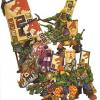Search the Community
Showing results for tags 'Smartphone photography'.
-
For many, herein lies an article which can safely be filed away under the title ` I Already Know.` A lot of us have smart or mobile phones with camera built in. Not a lot of us have what is required for high quality photographs of miniatures: really good digital cameras, light boxes, time and patience (I myself lack all four. Particularly the last two). However, all too often I see images posted of miniatures photographed with mobile phone cameras which are of pitifully poor quality. Bad lighting. Camera focused on the base or table. Camera focused on the keyboard behind the miniatures. Camera focused on the image on the book/miniature box behind/under the miniatures. Photo includes a lot of surroundings. Needs cropping. When you spent time painting miniatures to the best of your ability, isn’t it a shame you can’t present them a little better? If your painting isn’t all that good, if you can post reasonable images then other B&C members can give useful advice on how to improve your painting. The point of this tutorial is to show that it’s not that hard to take reasonable (dare I say decent?) images with the camera of a smart phone. Quickly too. Gear 1. Camera-equipped mobile or smart phone. If you have a digital camera, even a very basic one, you can improve your photographs with a bit more time and preparation. 2. Photographic background. Nothing fancy. A plain sheet of white paper under the miniature and curving up behind them will suffice, but a decent coloured one is better. Like the one you can download for free and print off from the B&C itself: http://www.bolterandchainsword.com/files/file/7-photo-background/ Or, as I recently discovered, a black sheet (okay, I admit it: actually a plain black dress shirt or T-shirt). White paper background. Photographic gradient background Black sheet background All three were taken with the same camera, in the same lighting, same position. But that last one came out awful, didn't it? So I tried this: Put a piece of white paper in the corner of the photo. And cropped it out. Far better. Optional You can of course get decent photos with your smart phone camera’s basic build in app (including cropping, on an iPhone), but personally I prefer an app with a few more options: cropping, at the very least and adjustable exposure if possible. I’m not into cameras at all and the word `photo exposure` used to make me grumble “Sounds complicated” and run away. But stick with me here. I use Camera+ (which will set you back all of a pound/couple of dollars/perhaps 200 yen?) but there are likely a lot of other good apps out there. By all means reply with suggestions. What to do I don’t have good light in my living room. A combined 30 & 38Watt double-ring light. I put the miniature on the background sheet somewhere as well lit as possible. Camera shake is also a problem so, if you don’t have some kind of tripod (I’ve seen some smartphone cases with built in tripods) then make sure you can rest your elbows/forearms against something to steady your hands as well as possible while you snap away. Of course, you could put your phone on a surface and use a timer, but I find I’m rarely able to get the angles I want that way. Now get reasonably close, but not so close that your camera can’t focus on the model (sounds obvious, but considering some of the blurred images I’ve seen...). Even the basic iPhone camera app will focus on whatever you tap on the screen, so tap about a bit until you’ve got it focused on the miniature (not the base. Often my camera picks up on the texture of the base and stubbornly tries to focus on that. Don’t fight the machine spirit. Guide it where you want it). Now, if you’re using Camera+ you can tap on the little plus in the top right of the focus box.... ….to lock the focus, then move the exposure circle around (alright, that photo's blurred terribly, but that's because I had to push the power and menu buttons simultaneously for a screenshot). Experiment with this as, moving the exposure circle to a dark area on the image will lighten everything (and can get you far lighter photos than you might first expect. Using the gradient background gives you lighter and darker areas to experiment with). You can also fiddle with exposure compensation, focus lock, exposure lock and white balance lock at the bottom of the screen. Not something I’ve yet fiddled with. Let’s keep this simple. So, you’ve got your image focused (and nicely exposed). So take some shots. If possible press the shutter icon lightly rather than snapping shots with the volume button, which will probably move the camera. As I said before, try to make sure your arms are braced firmly. And take at least two shots of each angle as one will probably come out badly. Once you’ve taken plenty of images from various angles (try standing the mini atop a paint pot for some shots from low angles. Just make sure the background sheet is always behind the mini, please!) you can put away the background and mini, grab a coffee and either email the photos to your PC for uploading or - with your camera app - do some cropping and fiddle with other options. Camera+ also lets you fiddle afterwards with not only the exposure but clarity, rotating/flipping, straightening (if you’re shots are a bit wonky), tints, duotone, soft focus, film grain (combined with the sepia filter and film-like frame you can put together some nice shots), sharpening, blurring, saturation, temperature, brightness and contrast, highlights and shadows and vignette. All: Lightbox -> Edit -> The Lab. Most of which I have never used because I haven’t the time and I just want some good, clear shots. As good as you can get with a digital camera and a light box? No. But decent, I hope.


